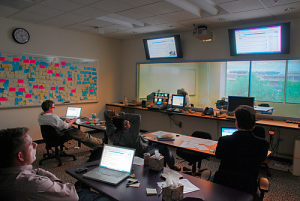Ah the one-way mirror. Also, confusingly, called a two-way mirror.
Iconic in traditional usability testing practice and imagery. But do we really need two rooms to conduct valid product testing anymore? Not just as a convenient room for observers, but to actually moderate from ‘behind the glass’, separated from the participant, communicating via mics and speakers?

Was this merely a quaint effort to legitimize usability testing as a ‘scientific’ practice and is now laughably passé? Or are there logical and enduring reasons why moderating from the ‘control room’ is best practice for summative / benchmark types of tests?
Let’s listen in on a prototypical conversation between two UX Testing pros - often, but not always, representing different generations (such as X vs Y/Z) or different program backgrounds (such as Cog Psy vs. Design Thinking)....
Behind the Glass
by: Prakhantree
SCENE: A chance meeting at a Palo Alto coffee shop
... with Kevin! The highly-skilled, well-respected UX veteran
...and Katya! The sharp, young UX researcher
Link in case the above embed doesn't work:
http://www.xtranormal.com/watch/14382433/behind-the-glass
Morale of the skit?
I firmly believe either physical setup is suitable, and will yield completely valid and useful results, assuming the moderator has appropriately established rapport and set expectations to offset the potential negatives of each approach.
So what matters then?
Beyond the most obvious factors of type of test and actual availability of a fancy lab, it comes down mostly to preference. I’ve summarized my learnings below. You're welcome ;-)
Vel’s guide to choosing your side of the glass
Ask yourself these simple questions to gauge if moderating from ‘behind the glass’ could be right for you!
Practical Factors
Might I want or need to have discreet communication with other observers, such as a notetaker, client, or product experts during testing?
- to clarify a path or feature
- to acknowledge an issue together
- to ensure an error, comment, etc. is captured (if a notetaker is assisting)
- to troubleshoot a system issue
- to gather and plan for any follow-up questions in real time
Is the lab setup adjustable enough / ergonomic to sit with the participant?
- sitting right next to the user can strain the neck (especially with multiple tests in a day)
- might have to balance your laptop on your lap
- have to ensure participant doesn’t view your note-taking screen
- sitting behind the user might feel creepy
- can be hard to get an unobstructed view of the screen without getting ‘too close’
- hard to change positions mid-test if you’re uncomfortable
- small rooms can become uncomfortably warm with two people and the heat of equipment
Personal Factors
Do I like to have more privacy while I test (especially if there are no other observers with you) ?
- to munch that Cliff bar
- scratch your nose
- take off your shoes
- yawn and stretch
- freely face-palm and head-desk
- stress less about bodily noises
Am I sensitive to hygiene variability?
- the user that just ‘came from a run!’
- came from the bar
- came from the burrito bar
- came from the cigar bar
- isn’t quite over that phlegmatic cough (!)
- all of the above at once in a perfect storm
If few or none of the above are super-important to you, or you have work-arounds/solutions for them, then you will probably not perceive any benefit to moderating in a separate control room. Or perhaps you discovered a few benefits that you hadn't thought about. Either way, h
appy testing!